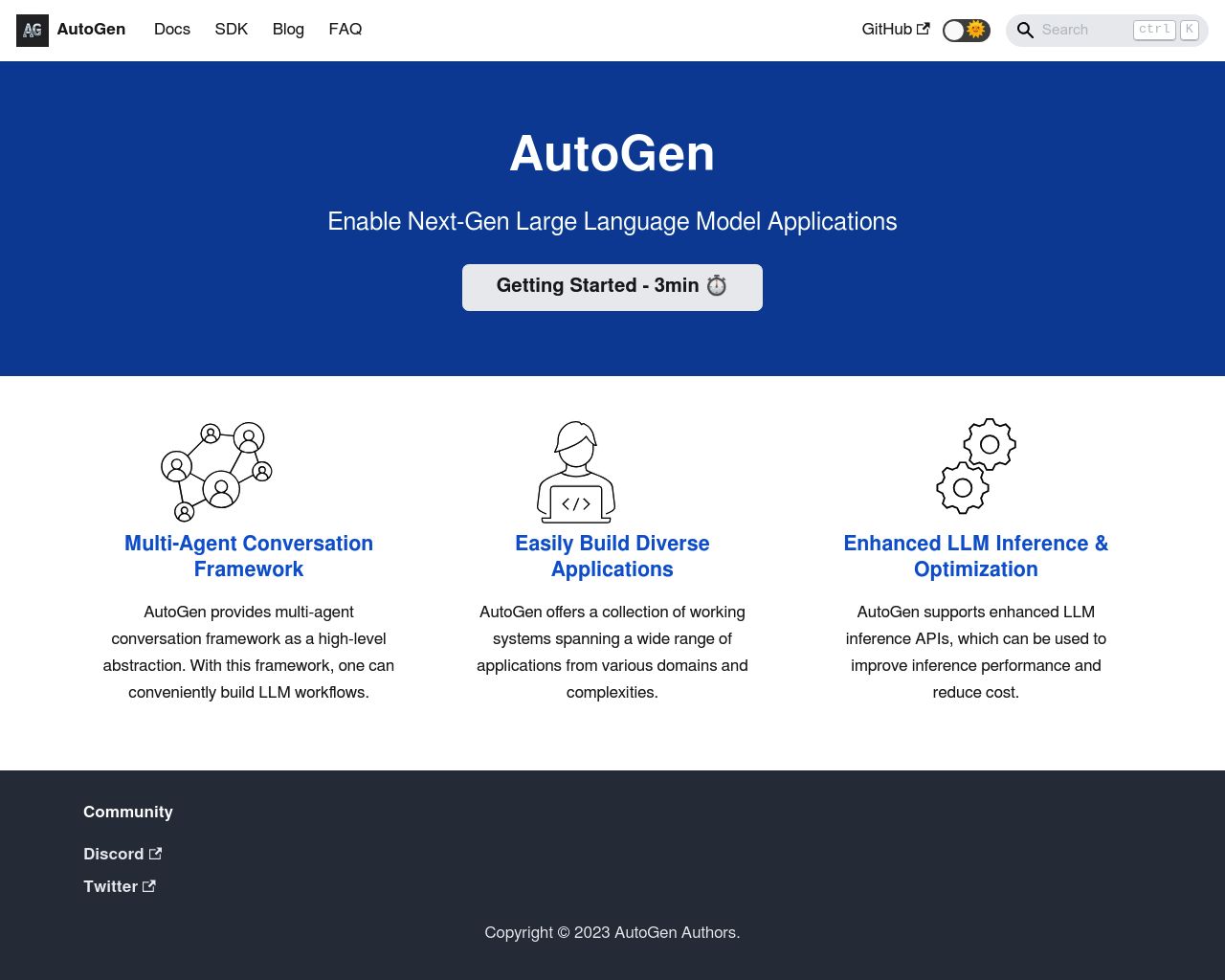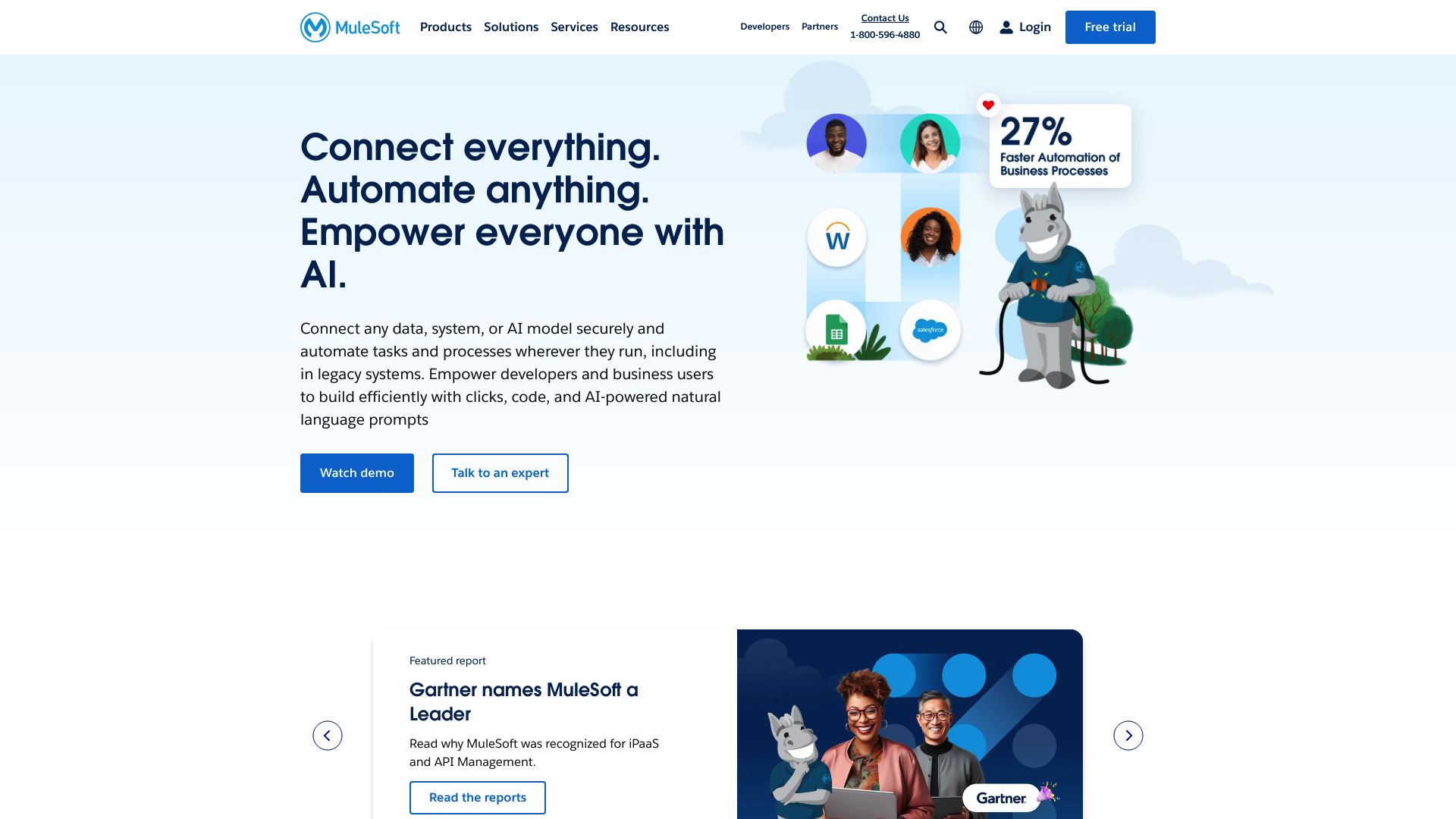AutoGen vs. Mulesoft: AI Collaboration Meets Enterprise Integration
Artificial Intelligence reshapes how businesses operate, innovate, and compete. As developers and IT leaders seek powerful tools to harness AI’s potential, three platforms stand out: AutoGen vs. Mulesoft, and SmythOS. This comparison delves into their unique approaches to AI integration, multi-agent systems, and enterprise connectivity.
We’ll explore how AutoGen’s flexible framework for AI agent collaboration stacks up against Mulesoft’s robust API management and integration capabilities. Finally, we’ll examine how SmythOS combines and extends these features, offering a comprehensive solution for AI development and deployment. Whether you’re a seasoned developer, a business leader, or an AI enthusiast, this analysis will help you navigate the evolving landscape of AI platforms and choose the solution that best fits your needs.
AutoGen Overview
AutoGen empowers developers to build sophisticated AI applications using multi-agent conversations. This open-source framework orchestrates customizable agents that interact with each other, Large Language Models (LLMs), tools, and humans to tackle complex tasks.


AutoGen’s core strength lies in its multi-agent conversations. These agents collaborate autonomously or with human input, adapting to various use cases. The framework maximizes LLM performance through enhanced inference capabilities, including tuning, caching, and error handling. This optimization proves crucial when working with resource-intensive models like GPT-4.
AutoGen’s core strength lies in its multi-agent conversations. These agents collaborate autonomously or with human input, adapting to various use cases.
Developers can tailor agents to specific task requirements, integrating LLMs, human inputs, and external tools. AutoGen supports both fully autonomous operations and human-in-the-loop problem-solving, offering flexibility for applications where human oversight is essential. The framework demonstrates effectiveness across diverse applications, from automated task solving and code generation to complex problem-solving in group chats.
AutoGen provides debugging tools and logging functionalities for API calls, essential for diagnosing and refining LLM-based systems. The inclusion of EcoOptiGen, a cost-effective technique for tuning large language models, underscores AutoGen’s focus on enhancing LLM efficiency. While AutoGen offers powerful capabilities, it requires coding knowledge for setup and lacks a visual builder or no-code editor, potentially limiting accessibility for non-technical users.
Mulesoft Overview
Mulesoft offers a comprehensive integration platform that empowers businesses to connect data, applications, and devices across on-premises and cloud environments. The Anypoint Platform serves as Mulesoft’s flagship product, providing full-lifecycle API management capabilities. This platform enables organizations to design, build, and scale APIs and integrations, fostering innovation and digital transformation.
Mulesoft offers a comprehensive integration platform that empowers businesses to connect data, applications, and devices across on-premises and cloud environments.


Mulesoft’s API-led connectivity approach stands out, allowing businesses to create reusable assets and build security into their digital touchpoints. This methodology proves particularly valuable for enterprises seeking to streamline their integration processes and enhance overall operational efficiency. The platform’s integration with Einstein AI further augments its capabilities, enabling rapid project initiation through natural language prompts and improving developer productivity.
Mulesoft’s API-led connectivity approach stands out, allowing businesses to create reusable assets and build security into their digital touchpoints.
Another key strength of Mulesoft lies in its robust security and governance features. The Anypoint Flex Gateway and API Governance tools ensure secure and controlled API management, critical for maintaining data integrity and compliance in AI and data integration projects. These features make Mulesoft an attractive option for organizations dealing with sensitive data or operating in heavily regulated industries.
However, Mulesoft’s enterprise-focused approach may present a steeper learning curve for smaller businesses or individual developers. The platform’s extensive capabilities, while powerful, can be overwhelming for users seeking simpler integration solutions. Additionally, pricing information is not readily available on their website, potentially making it difficult for potential customers to assess the platform’s cost-effectiveness without direct engagement with sales representatives.
Feature Comparison
AutoGen and Mulesoft offer distinct approaches to AI and integration capabilities, with notable feature gaps in core components and security. AutoGen excels in multi-agent collaboration and autonomous problem-solving, leveraging its framework for creating customizable AI agents that can interact with each other and external tools. This capability allows for complex task solving and code generation. In contrast, Mulesoft focuses on API-led connectivity and enterprise integration, providing robust tools for API management and data orchestration across various systems.
Security features highlight a significant difference between the two platforms. Mulesoft emphasizes enterprise-grade security with features like the Anypoint Flex Gateway and comprehensive API governance tools, critical for maintaining data integrity in large-scale integrations. AutoGen, while supporting OAuth for API authentication, lacks specific mentions of advanced security features like data encryption or IP control, which may be a concern for organizations handling sensitive data.
In terms of core components, AutoGen’s strength lies in its flexible agent architecture, supporting various AI models and allowing for autonomous operations with optional human oversight. Mulesoft, on the other hand, offers a more structured approach with its Anypoint Platform, providing full-lifecycle API management and integration capabilities. While Mulesoft integrates AI capabilities through Einstein AI, it does not offer the same level of customizable AI agent creation as AutoGen. This gap in AI agent flexibility could be significant for users looking to develop complex, autonomous AI systems within their integration workflows.
Feature Comparison Table
| AutoGen | Mulesoft | SmythOS | |
|---|---|---|---|
| CORE FEATURES | |||
| Visual Builder | ❌ | ✅ | ✅ |
| No-Code Options | ❌ | ✅ | ✅ |
| Memory & Context | ✅ | ❌ | ✅ |
| Explainability & Transparency | ✅ | ❌ | ✅ |
| Problem-Solving Capabilities | ✅ | ❌ | ✅ |
| Human-AI Interaction | ✅ | ❌ | ✅ |
| Audit Logs for Analytics | ✅ | ❌ | ✅ |
| Agent Work Scheduler | ❌ | ✅ | ✅ |
| SECURITY | |||
| Constrained Alignment | ❌ | ✅ | ✅ |
| Data Encryption | ✅ | ❌ | ✅ |
| IP Control | ❌ | ✅ | ✅ |
| COMPONENTS | |||
| Huggingface AIs | ✅ | ❌ | ✅ |
| Zapier APIs | ✅ | ❌ | ✅ |
| All other APIs, RPA | ✅ | ❌ | ✅ |
| Logic | ✅ | ❌ | ✅ |
| Data Lakes | ❌ | ✅ | ✅ |
| DEPLOYMENT OPTIONS (EMBODIMENTS) | |||
| Staging Domains | ❌ | ✅ | ✅ |
| Production Domains | ❌ | ✅ | ✅ |
| Deploy as Scheduled Agent | ❌ | ❌ | ✅ |
| Scalability | ✅ | ❌ | ✅ |
| DATA LAKE SUPPORT | |||
| Hosted Vector Database | ❌ | ✅ | ✅ |
| Sitemap Crawler | ❌ | ❌ | ✅ |
| YouTube Transcript Crawler | ❌ | ❌ | ✅ |
| URL Crawler | ✅ | ❌ | ✅ |
| PDF Support | ✅ | ❌ | ✅ |
Best Alternative to AutoGen and Mulesoft
SmythOS stands out as the superior alternative to AutoGen and Mulesoft, offering a comprehensive platform for AI agent development and deployment. Our solution combines the best of both worlds, providing the flexibility of AutoGen’s multi-agent collaboration with Mulesoft’s enterprise-grade integration capabilities.
We excel in ease of use, boasting a visual builder and no-code options that democratize AI development. This allows both technical and non-technical users to create sophisticated AI agents without extensive coding knowledge. Our drag-and-drop interface streamlines the process, making AI accessible to a broader audience.
We excel in ease of use, boasting a visual builder and no-code options that democratize AI development. This allows both technical and non-technical users to create sophisticated AI agents without extensive coding knowledge.
Our feature set surpasses both AutoGen and Mulesoft in critical areas. We offer robust memory and context management, ensuring AI agents maintain coherent interactions across sessions. Our platform supports autonomous agents with problem-solving capabilities, enabling complex task automation. Unlike AutoGen, we provide advanced security features including data encryption and IP control, addressing enterprise-level concerns.
SmythOS shines in its deployment versatility. We support a wide range of deployment options, including APIs, webhooks, scheduled agents, and integration with popular platforms like ChatGPT. This flexibility allows users to seamlessly incorporate AI agents into existing workflows and systems, a capability not fully realized in AutoGen or Mulesoft.
Our platform’s scalability sets us apart. We offer hosted solutions for both development and production environments, ensuring smooth transitions from testing to live deployments. With our agent work scheduler and comprehensive logs and monitoring, we provide unparalleled control and oversight of AI operations, features lacking in both AutoGen and Mulesoft.
Conclusion
AutoGen, Mulesoft, and SmythOS each offer unique strengths in the AI and integration landscape. AutoGen excels in multi-agent collaboration and autonomous problem-solving, ideal for developers seeking flexible AI frameworks. Mulesoft shines in enterprise-grade API management and data orchestration, catering to large-scale integration needs.
However, SmythOS emerges as the superior choice, combining the best of both worlds with additional innovative features. Our platform’s intuitive drag-and-drop interface and extensive integration ecosystem (300,000+ integrations) democratize AI development, making it accessible to technical and non-technical users alike. SmythOS’s ’Create Once, Deploy Anywhere’ approach offers unparalleled flexibility, allowing seamless deployment across various platforms and services.
While AutoGen and Mulesoft have their merits, SmythOS’s comprehensive feature set—including advanced security measures, multimodal capabilities, and scalable architecture—positions it as the most versatile and user-friendly option. Our platform not only simplifies AI agent creation but also provides robust tools for debugging, monitoring, and scaling AI solutions.
Experience the future of AI automation with SmythOS. Create a free account to explore our platform’s capabilities, or dive into our documentation for in-depth insights. Unlock the full potential of AI for your business with SmythOS—where innovation meets simplicity.
Last updated:
Disclaimer: The information presented in this article is for general informational purposes only and is provided as is. While we strive to keep the content up-to-date and accurate, we make no representations or warranties of any kind, express or implied, about the completeness, accuracy, reliability, suitability, or availability of the information contained in this article.
Any reliance you place on such information is strictly at your own risk. We reserve the right to make additions, deletions, or modifications to the contents of this article at any time without prior notice.
In no event will we be liable for any loss or damage including without limitation, indirect or consequential loss or damage, or any loss or damage whatsoever arising from loss of data, profits, or any other loss not specified herein arising out of, or in connection with, the use of this article.
Despite our best efforts, this article may contain oversights, errors, or omissions. If you notice any inaccuracies or have concerns about the content, please report them through our content feedback form. Your input helps us maintain the quality and reliability of our information.
